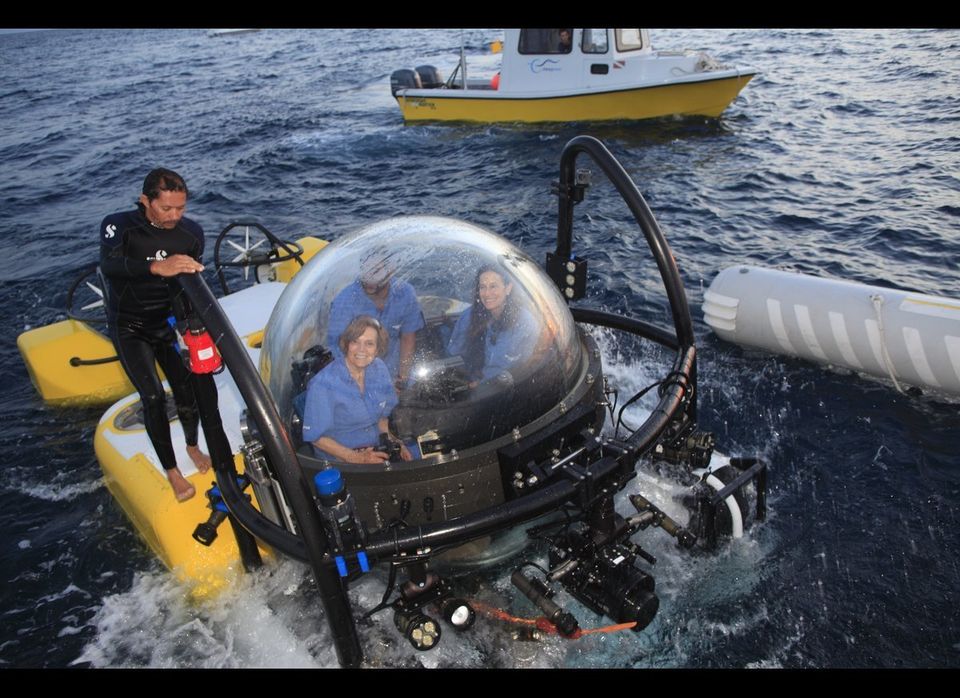By Jenifer Austin Foulkes, Oceans Program Manager, Google:
Kip Evans and Shari Sant Plummer left early in the morning to rendezvous with the Undersea Hunter support ship for the DeepSea sub. Shari and David Shaw made a 350 foot (120 meters) dive in the sub to explore Hannibal Bank, where they saw numerous stomatopod Mantis shrimp, who mate for life. Kip and Biff did a 120 foot dive to photograph the sub descent. They saw a dead fish carcas at 300 feet being eaten by crabs. They also saw pink coral with white fringes, and a coral that looked like a taco-salad in a flour tortilla bowl. A big ray with false black eyespots on each wing swam by at 340 feet.
Sylvia Earle and Shannon Joy went on the afternoon submarine dive. Sylvia said it was fantastic and the sub took video transects, performing some of the first ever explorations of Hannibal bank. They went down to a maximum dive depth of 195 meters (640 feet). A beautiful mobula ray swooped in and circled the sub, curious about the light, before gliding away gracefully.
Many pteropod flying sea butterflies and small jellies about 2 inches long pulsed through the water column. The water was thick with plankton like a soup. You could see a green shimmering, where the warm and cold water layers mixed, creating what's known as a thermocline, at about 20 meters. [Text continues after images.]
Images courtesy of Kip Evans and Mission Blue
The sub touched down on the bottom at 150 meters, which is actually the top of Hannibal Bank. This bottom was sandy with scattered rock patches. On the open sand were countless small burrows, like holes on a colander, which were somebody's little homes. There were bright, 6 inch long red scorpion fish clustered near the rocks; one was even a foot long.
They saw a little red octopus with spiked skin on a rock perched near a scorpionfish. A gray moray eel and numerous tongue fish were among the thousands of small animals living on the sea floor. On the rocks, there were black coral, some pale, white soft-corals, a white, solitary coral and beautiful, pink hydrozoan corals as well. White sponges encrusted patches on the ocean floor. They observed a kind of worm that looks like spaghetti with papery tubes as wide as your little finger with red plumes inside. A big ball of fishing line was a jarring reminder of the fishing that still occurs here.
Swimming in the water column were fist-sized ctenophores and a 20 meter long siphonophore- a long, iridescent colonial relative of the jellyfish. It looked like a shimmering chain of gelatinous bodies with long-trailing, shimmering tentacles extending a foot below.
Several large crabs and numerous bright red, deep sea Galatheid crabs, also called squat lobsters, sat on the bottom. Looking up from the bottom, it appeared as if they were in a deep twilight.
While filming the DeepSea, Kip saw at 43 feet a red layer of plankton that looked like smoke along a 10 foot carpet running under water. STRI director Biff Bermingham swam in and out of the red layer.
While Mission Blue divers were in the sub, STRI expedition lead scientist Dr. Héctor Guzmán analyzed data from the previous dives aboard the SeaHunter. Dr. Guzmán will make his second dive on Hannibal Bank tomorrow morning.
Back on the boat, Ricardo Cisneros and I went with dive expert Kevan Mantell, Philippe and Rina to the Twin Pinnacles, two rock outcrops that stand at the intersection of cold water upwelling and warm water coming down from a stream on the near by island. The currents and water make it just right for a baby fish rookery, and we saw swarms of them swimming and eating plankton.
In addition, there were amazing schools of large jacks, King angelfish, butterflyfish and damselfish. The wall provides a fish cleaning station, where big fish come in to be cleaned of parasites by the butterflyfish. Kevan remembers not too long ago, when you'd see at least 50 sharks swimming around the other fish, but I saw none. They've likely all been killed for shark fin soup. Imagine, how much more sustainable tourism dollars could be made if people could come and dive with sharks!
Beautiful coral fans encrusted the rock cliff faces, providing hiding spots for black and bright yellow dog-faced puffers and one beautiful, big Porcupine pufferfish (Diodon hystrix). A beautiful green moray eel was cleaned by a little blue-striped angelfish. He smiled at me, and I kept my distance.
Before sunset, we took an inflatable boat out to watch the beautiful pelicans and shore birds along the beach. This is a time when mother pelicans bring their young here to feed. We took the boat closer to shore, and as we neared the surf line, we saw a crocodile raise up out of the water and then slip back down. It's dangerous to walk along these beaches. Kevan noted that crocodiles have done wonders for deterring snail poaching along the coast. Yay, crocs!
To aid in fish identification, Biff directed me to a wonderful iphone/ipad app that STRI has published. Search on iTunes for "Fishes: East Pacific. An identification guide for the shorefish fauna of the tropical eastern Pacific." Read more about it here!
